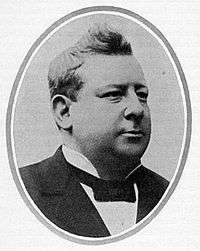Stockholms-Tidningen
Stockholms-Tidningen (meaning the Stockholm Times in English) was a Swedish language morning newspaper published in Stockholm, Sweden, between 1889 and 1984 with an interruption from 1966 to 1981. It was one of the major dailies in the country together with Dagens Nyheter and Aftonbladet in the 1960s.[1]
 | |
| Type | Daily newspaper |
|---|---|
| Founder(s) | Anders Jeurling |
| Founded | 1889 |
| Political alignment | Social democrat |
| Language | Swedish |
| Ceased publication | 1984 |
| Headquarters | Stockholm |
History and profile

Stockholms-Tidningen was established by Anders Jeurling in 1889.[2][3][4] The paper was based in Stockholm.[3] During its early stage it had three editions: morning edition, evening edition and provincial edition.[5] However, in 1890 only two editions continued.[5]
In order to gain larger readership the price of Stockholms-Tidningen was kept low and its content included popular and concentrated news.[2] The paper had a circulation of 10,000 copies in 1890 and 42,000 copies in 1894.[6] It achieved a circulation more than 100,000 copies in 1900.[6] Thus, it became the first Swedish newspaper which exceeded that amount of circulation[4][7] and was the first mass circulation paper in the country.[8][9] The paper kept its high circulation levels in the 1920s.[6]
On 19 September 1931, Stockholms Dagblad merged with Stockholms-Tidningen.[10] The paper along with Stockholms Dagblad, Svenska Dagbladet and Aftonbladet was purchased by Torsten Kreuger.[11] Specifically, he became the owner of Stockholms-Tidningen and Aftonbladet in 1932.[11] Both papers supported the Liberal party under the ownership of Kreuger[5] until 1956 when he sold them to the Swedish Trade Union Confederation.[2][11]
Upon the ownership change Stockholms-Tidningen became a supporter of social democratic stance.[2][12] E. B. Rinman,[13] Sven O. Andersson and Anders Johansson are among the editors-in-chief of the daily.[12] Else Kleen published fashion-related articles in the paper from the 1910s to the 1950s under the pen name of Gwen.[14]
In 1966, just before its first closure, Stockholms-Tidningen switched its format to tabloid to increase its circulation and Gunnar Fredriksson was appointed the editor-in-chief.[5] However, these changes did not work and the paper ceased publication on 27 February 1966.[15][16][17]
In October 1981 Stockholms-Tidningen was relaunched and was owned by the Social Democratic Party.[18] However, it was closed down in 1984.
See also
References
- Gert Hekma; Alain Giami (14 May 2014). Sexual Revolutions. Palgrave Macmillan. p. 26. ISBN 978-1-137-32146-6. Retrieved 20 December 2014.
- Newspapers in International Librarianship: Papers Presented by the Newspaper Section at IFLA General Conferences. Walter de Gruyter. 1 January 2003. p. 18. ISBN 978-3-11-096279-6. Retrieved 20 December 2014.
- Byron J. Nordstrom (2010). Culture and Customs of Sweden. ABC-CLIO. p. 84. ISBN 978-0-313-34371-1. Retrieved 20 December 2014.
- Lennart Schön (27 April 2012). An Economic History of Modern Sweden. Taylor & Francis. p. 369. ISBN 978-1-136-33850-2. Retrieved 20 December 2014.
- Karl Erik Gustafsson; Per Rydén (2010). A History of the Press in Sweden (PDF). Gothenburg: Nordicom. ISBN 978-91-86523-08-4. Archived from the original (PDF) on 13 February 2015. Retrieved 13 February 2015.
- Mats Deland (2001). The Social City: Middle-way Approaches to Housing and Suburban Governmentality in Southern Stockholm 1900 - 1945. Mats Deland. p. 257. ISBN 978-91-88882-17-2. Retrieved 13 February 2015.
- Marie Söderberg. "The Series Novels at the End of the 19th Century. A Comparison between Japanese and Swedish Newspapers" (Working Paper). The European Institute of Japanese Studies. Retrieved 20 December 2014.
- Stig Hadenius; Lennart Weibull (1999). "The Swedish Newspaper System in the Late 1990s. Tradition and Transition" (PDF). Nordicom Review. 1 (1). Retrieved 31 December 2014.
- M. Ellefson (2011). "Remapping Journalism History:Development of the Press in the Swedish Empire and Its Former Colonies Finland, Estonia and Livonia until the Early 20th Century" (PDF). Medien & Zeit. 26 (4). Retrieved 30 December 2014.
- Th. Westrin, ed. (1918). "Stockholms dagblad". Nordisk familjebok (in Swedish). 27. Stockholm: Nordisk familjeboks förlag. pp. 9–13.
- "The Hierta epoch, 1830-1851". Aftonbladet. Retrieved 20 December 2014.
- Tor Sellström (1999). Sweden and National Liberation in Southern Africa: Formation of a popular opinion (1950-1970). Nordic Africa Institute. p. 87. ISBN 978-91-7106-430-1. Retrieved 20 December 2014.
- Irene Scobbie, ed. (2006). Historical Dictionary of Sweden (PDF) (Second ed.). Lanham, Maryland: The Scarecrow Press, Inc. p. 193. Retrieved 30 December 2016.
- Wilfrid Fleisher (1956). Sweden, the Welfare State. New York: John Day. p. 161. Retrieved 20 December 2014. – via Questia (subscription required)
- Frederic Fleisher (August 1966). "The Swedish Press Subsidy Plan and the Collapse of Stockholms-Tidningen". International Communication Gazette. 12 (3). Retrieved 4 March 2015.
- Nick Couldry; James Curran (1 January 2003). Contesting Media Power: Alternative Media in a Networked World. Rowman & Littlefield. p. 93. ISBN 978-0-7425-2385-2. Retrieved 20 December 2014.
- Klaus Misgeld; Karl Molin (1 November 2010). Creating Social Democracy: A Century of the Social Democratic Labor Party in Sweden. Penn State Press. p. 112. ISBN 978-0-271-04344-9. Retrieved 20 December 2014.
- John Vinocur (18 October 1981). "New paper starts in Swedish capital". The New York Times. Stockholm. Retrieved 20 December 2014.
| Wikimedia Commons has media related to Stockholms-Tidningen. |